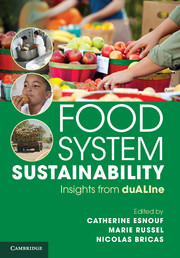Book contents
- Frontmatter
- Contents
- Foreword
- Acknowledgements
- Introduction
- 1 Context: new challenges for food systems
- 2 Consumption and consumers
- 3 Carbon footprint and nutritional quality of diets in France
- 4 Food systems
- 5 Industrial organisation and sustainability
- 6 Urbanisation and the sustainability of food systems
- 7 Losses and wastage
- 8 International trade, price volatility and standards for sustainability
- 9 Elements for a foresight debate on food sustainability
- 10 A critical panorama of methods used to assess food sustainability
- Conclusion
- References
- List of abbreviations
- List of duALIne experts
- Index
4 - Food systems
Published online by Cambridge University Press: 05 April 2013
- Frontmatter
- Contents
- Foreword
- Acknowledgements
- Introduction
- 1 Context: new challenges for food systems
- 2 Consumption and consumers
- 3 Carbon footprint and nutritional quality of diets in France
- 4 Food systems
- 5 Industrial organisation and sustainability
- 6 Urbanisation and the sustainability of food systems
- 7 Losses and wastage
- 8 International trade, price volatility and standards for sustainability
- 9 Elements for a foresight debate on food sustainability
- 10 A critical panorama of methods used to assess food sustainability
- Conclusion
- References
- List of abbreviations
- List of duALIne experts
- Index
Summary
This chapter focuses on food systems using an innovative dual approach. First of all, by considering them in interaction with energy and chemical systems within ecosystems, it poses the question of resource allocation (land and biomass). Second, a socioeconomic approach then highlights the diversity of these food systems. Different types of systems co-exist and reflect different ways of producing, processing, distributing and consuming food products. The ‘global’ food system is a constantly changing combination of these different types of systems, all of which influence each other.
Thanks to this dual approach to food systems, new research questions have emerged. New analytical frameworks would enable a clearer understanding of the interconnections between food systems within ecosystems, on the one hand, and their diversity and constant recombination on the other.
Introduction
Referring to the pioneering work of Malassis (1996), Rastoin et al. (2010) defined a food system (FS) as
an interdependent network of stakeholders (companies, financial institutions, public and private organisations) localised in a given geographical area (region, state, multinational region), participating directly or indirectly in the creation of a flow of goods and services geared towards satisfying the food needs of one or more groups of consumers, both locally and outside the area considered.
- Type
- Chapter
- Information
- Food System SustainabilityInsights From duALIne, pp. 69 - 100Publisher: Cambridge University PressPrint publication year: 2013
- 20
- Cited by

